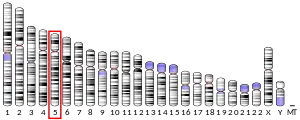Forkhead box D1 is a protein that in humans is encoded by the FOXD1 gene.[4] Forkhead d1 is a kidney expressed transcription factor maps at the chromosome 5 at position 5q12—q13, identified in Drosophila forkhead protein and mammalian HNF3 transcription factor.[5] The name of was derived from two spiked head structures in the embryos of Drosophila forkhead mutant.[5] It belong to transcription factor family that displays remarkable functional diversity and involved in a wide variety of biological processes.[5] The most commonly used synonyms for Forkhead D1 are, FOX D1, FREAC-4 and BF2.[5]
Structure
The Forkhead domain in FOXD1 is distinctive from other members of the same family except, FREAC-9 also known as FOXD2.[6] The amino acid sequence of the DNA binding forkhead motif of FREAC-4 is similar to FREAC-9, except 12 substitution are present at the nucleotide level.[6] The DNA binding domain is winged helix consist of around 100 amino acids, has four helices and two stranded beta-sheets, the sequence extends from nucleotide 2521 to 4792.[7] This gene is estimated to be approximately 2.5 kilo base pairs and, most likely introns less.[7] The motif at NH2 terminal part is highly acidic and rich in prolines at COOH terminal, this is similar to the transcription factor UBF and WT-1.[7] It is indicated in cotransfection experiments, that the tumour suppressor gene p53 and WT-1 are potential regulators of FREAC-4.[7] FOXD1 is expressed by two kidney derived cell line COS 7 and 293 cells.[7] It also has high degree of sequence similarity with FOXD1 found by cloned mouse cDNA.[8]
Functions
Studies of the orthologous mouse protein indicate that it functions in kidney development by promoting nephron progenitor differentiation, and it also functions in the development of the retina and optic chiasm. It may also regulate inflammatory reactions and prevent autoimmunity.[4]
FOXD1 and stromal cell have essential function during kidney Morphogenesis.[8] Placental growth factor (PIGF) is a direct and physiologically relevant transcriptional target of FOXD1 and hence, it is co-expressed with FOXD1 for the development of renal stroma.[8] Two isoforms of PIGF, PIGF1 and PIGF 2 are found in human. In an experiment, three genes were found to be identified by induced FOXD1 in Northern blotting. First, PIGF initiates stromal signal that regulate epithelial differentiation which functions as a growth factor in reactive angiogenesis during wound healing and tumorigenesis.[8] Second, heparin binding epidermal growth factor and lastly, the bHLH protein G0S8.[8]
Foxd1 is also required for proper formation of optic chiasm.[9] During the formation of optic chiasm, Foxd1 is expressed in VT retina, as well as in the ventral diencephalon for retinal development and chiasm morphogenesis.[9] During visual system development, retinal ganglion cell (RGC) axons leave the retina via optic disc until they reach the optic chiasm.[9] Foxg1 and Foxd1 are expressed in adjacent domains in the neural tube at the time, the optical vesicle evaginates. Misexpression of Foxd1 and Foxg1 in chick retina creates projection error in retinal axons along the antiposterior axis in the tectum and, it also plays a role in the specification of contralateral RGCs.[9] It is determined that Foxd1 is essential for the correct formation of optic chiasm.
FOX D1 expressed and function in Glioma cell behaviour, it upregulates and directly correlates with the glioma grade.[10] Delayed expression of FOX D1 causes decreased glioma cell growth and reduce cell migration. There is a high probability that FOXD1 can serve as a novel regulator of glioblastoma cell behaviour that could be used as a novel target for gene targeted therapies.[10] In mice, Foxd1 is expressed in the mesenchyme surrounding the pituitary gland, which is an essential source for signaling factors that regulate pituitary organogenesis. It suggests that Foxd1 is indirectly involved in Lhb expression and cartilage formation.[11]
Disease
The chromosomal duplication in the region 5q12-13 of chromosome 5 causes dysplastic kidneys and mental disorders which is relevant to tissue distribution o FREAC-4 mRNA.[5]
References
- 1 2 3 GRCh38: Ensembl release 89: ENSG00000251493 - Ensembl, May 2017
- ↑ "Human PubMed Reference:". National Center for Biotechnology Information, U.S. National Library of Medicine.
- ↑ "Mouse PubMed Reference:". National Center for Biotechnology Information, U.S. National Library of Medicine.
- 1 2 "FOX D1 Forkhead box D1".
- 1 2 3 4 5 Carlsson P, Mahlapuu M (2002). "Forkhead transcription factors: key players in development and metabolism". Developmental Biology. 250 (1): 1–23. doi:10.1006/dbio.2002.0780. PMID 12297093.
- 1 2 Ernstsson S, Betz R, Lagercrantz S, Larsson C, Ericksson S, Cederberg A, Carlsson P, Enerbäck S (1997). "Cloning and characterization of freac-9 (FKHL17), a novel kidney-expressed human forkhead gene that maps to chromosome 1p32-p34". Genomics. 46 (1): 78–85. doi:10.1006/geno.1997.4986. PMID 9403061.
- 1 2 3 4 5 Ernstsson S, Pierrou S, Hulander M, Cederberg A, Hellqvist M, Carlsson P, Enerbäck S (1996). "Characterization of the human forkhead gene FREAC-4. Evidence for regulation by Wilms' tumor suppressor gene (WT-1) and p53". The Journal of Biological Chemistry. 271 (35): 21094–9. doi:10.1074/jbc.271.35.21094. PMID 8702877.
- 1 2 3 4 5 Hatini V, Huh SO, Herzlinger D, Soares VC, Lai E (1996). "Essential role of stromal mesenchyme in kidney morphogenesis revealed by targeted disruption of Winged Helix transcription factor BF-2". Genes & Development. 10 (12): 1467–78. doi:10.1101/gad.10.12.1467. PMID 8666231.
- 1 2 3 4 Herrera E, Marcus R, Li S, Williams SE, Erskine L, Lai E, Mason C (2004). "Foxd1 is required for proper formation of the optic chiasm". Development. 131 (22): 5727–39. doi:10.1242/dev.01431. PMID 15509772.
- 1 2 Gao YF, Zhu T, Mao XY, Mao CX, Li L, Yin JY, Zhou HH, Liu ZQ (2017). "Silencing of Forkhead box D1 inhibits proliferation and migration in glioma cells". Oncology Reports. 37 (2): 1196–1202. doi:10.3892/or.2017.5344. PMID 28075458.
- ↑ Gumbel JH, Patterson EM, Owusu SA, Kabat BE, Jung DO, Simmons J, Hopkins T, Ellsworth BS (2012). "The forkhead transcription factor, Foxd1, is necessary for pituitary luteinizing hormone expression in mice". PLOS ONE. 7 (12): e52156. doi:10.1371/journal.pone.0052156. PMC 3526578. PMID 23284914.

